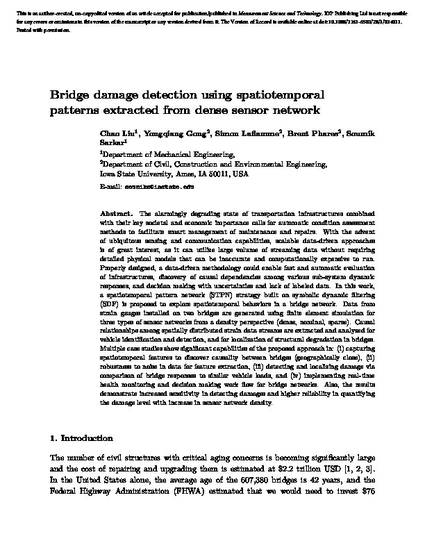
The alarmingly degrading state of transportation infrastructures combined with their key societal and economic importance calls for automatic condition assessment methods to facilitate smart management of maintenance and repairs. With the advent of ubiquitous sensing and communication capabilities, scalable data-driven approaches is of great interest, as it can utilize large volume of streaming data without requiring detailed physical models that can be inaccurate and computationally expensive to run. Properly designed, a data-driven methodology could enable fast and automatic evaluation of infrastructures, discovery of causal dependencies among various sub-system dynamic responses, and decision making with uncertainties and lack of labeled data. In this work, a spatiotemporal pattern network (STPN) strategy built on symbolic dynamic filtering (SDF) is proposed to explore spatiotemporal behaviors in a bridge network. Data from strain gauges installed on two bridges are generated using finite element simulation for three types of sensor networks from a density perspective (dense, nominal, sparse). Causal relationships among spatially distributed strain data streams are extracted and analyzed for vehicle identification and detection, and for localization of structural degradation in bridges. Multiple case studies show significant capabilities of the proposed approach in: (i) capturing spatiotemporal features to discover causality between bridges (geographically close), (ii) robustness to noise in data for feature extraction, (iii) detecting and localizing damage via comparison of bridge responses to similar vehicle loads, and (iv) implementing real-time health monitoring and decision making work flow for bridge networks. Also, the results demonstrate increased sensitivity in detecting damages and higher reliability in quantifying the damage level with increase in sensor network density.
Available at: http://works.bepress.com/simon_laflamme/39/

This is an author-created, un-copyedited version of an article accepted for publication/published in Measurement Science and Technology. IOP Publishing Ltd is not responsible for any errors or omissions in this version of the manuscript or any version derived from it. The Version of Record is available online at doi: 10.1088/1361-6501/28/1/014011. Posted with permission.